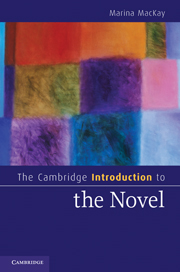Book contents
- Frontmatter
- Contents
- Acknowledgments
- About this book
- Chapter 1 Why the novel matters
- Miguel de Cervantes, Don Quixote (1605, 1615)
- Chapter 2 Origins of the novel
- Laurence Sterne, The Life and Opinions of Tristram Shandy, Gentleman (1759–67)
- Chapter 3 Narrating the novel
- James Hogg, The Private Memoirs and Confessions of a Justified Sinner (1824)
- Chapter 4 Character and the novel
- Nathaniel Hawthorne, The Scarlet Letter (1850)
- Chapter 5 Plotting the novel
- Gustave Flaubert, Madame Bovary (1857)
- Chapter 6 Setting the novel
- Charles Dickens, Bleak House (1853)
- Chapter 7 Time and history
- Virginia Woolf, To the Lighthouse (1927)
- Chapter 8 Genre and subgenre
- Graham Greene, The Ministry of Fear (1943)
- Chapter 9 Novel and anti-novel
- Thomas Pynchon, The Crying of Lot 49 (1966)
- Chapter 10 Novel, nation, community
- Salman Rushdie, Midnight's Children (1981)
- Chapter 11 Concluding
- Notes
- Glossary
- Further reading
- Index
- Cambridge Cultural Social Studies
Chapter 9 - Novel and anti-novel
Published online by Cambridge University Press: 05 June 2012
- Frontmatter
- Contents
- Acknowledgments
- About this book
- Chapter 1 Why the novel matters
- Miguel de Cervantes, Don Quixote (1605, 1615)
- Chapter 2 Origins of the novel
- Laurence Sterne, The Life and Opinions of Tristram Shandy, Gentleman (1759–67)
- Chapter 3 Narrating the novel
- James Hogg, The Private Memoirs and Confessions of a Justified Sinner (1824)
- Chapter 4 Character and the novel
- Nathaniel Hawthorne, The Scarlet Letter (1850)
- Chapter 5 Plotting the novel
- Gustave Flaubert, Madame Bovary (1857)
- Chapter 6 Setting the novel
- Charles Dickens, Bleak House (1853)
- Chapter 7 Time and history
- Virginia Woolf, To the Lighthouse (1927)
- Chapter 8 Genre and subgenre
- Graham Greene, The Ministry of Fear (1943)
- Chapter 9 Novel and anti-novel
- Thomas Pynchon, The Crying of Lot 49 (1966)
- Chapter 10 Novel, nation, community
- Salman Rushdie, Midnight's Children (1981)
- Chapter 11 Concluding
- Notes
- Glossary
- Further reading
- Index
- Cambridge Cultural Social Studies
Summary
If the novel is truly no longer novel, then many of our critical procedures for discussing it will need revision; perhaps, even, we shall do well to think of another name for it.
Bernard Bergonzi, The Situation of the Novel (1970)Or you can declare at the very start that it's impossible to write a novel nowadays, but then, behind your own back so to speak, give birth to a whopper, a novel to end all novels.
Günter Grass, The Tin Drum (1959)As early as 1752 at least one critic of the novel had reached the amusingly premature conclusion that “all the variety of which this species of literary entertainment is capable, seems almost exhausted, and even novels themselves no longer charm us with novelty.” That everything had already been done in the novel would become a recurrent complaint, but it reached its apotheosis around the middle of the twentieth century, in the decades that followed the spectacular technical accomplishments of modernist fiction. As Bernard Bergonzi put it in 1970, the postwar novelist “has inherited a form whose principal characteristic is novelty, or stylistic dynamism, and yet nearly everything possible to be achieved has already been done.” What could be done in fiction that the generation of Joyce and Kafka, Woolf and Faulkner, hadn't already accomplished? “They're like cats which have licked the plate clean,” conceded Henry Green, himself one of the most powerfully original novelists of the next generation: “You've got to dream up another dish if you're to be a writer.”
- Type
- Chapter
- Information
- The Cambridge Introduction to the Novel , pp. 148 - 158Publisher: Cambridge University PressPrint publication year: 2010

